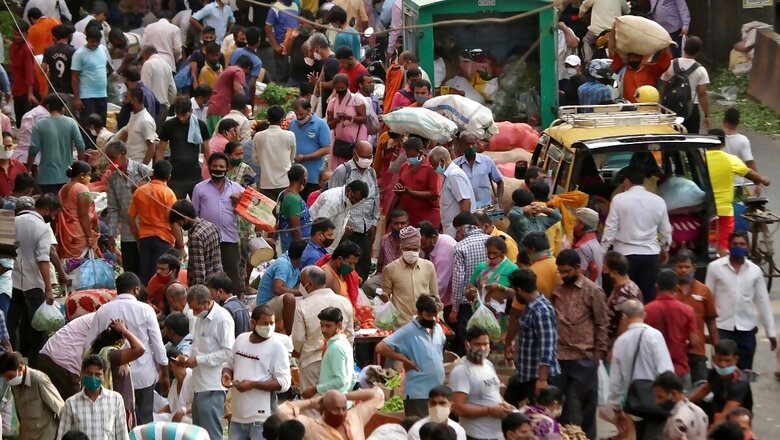
views
India is witnessing a second wave of novel coronavirus infections with the country now adding over 100,000 cases per day. Maharashtra, Karnataka, Kerala, Tamil Nadu, Andhra Pradesh, Chhattisgarh and Punjab have emerged as COVID-19 hotspots. To stem the next wave, India needs to act with urgency and ramp up the pace of vaccination by expanding coverage to all age groups, especially the young and mobile workforce.
There is sound social rationale behind the Indian government’s argument that the most vulnerable people in our society, especially senior citizens and those with co-morbidities, should get first preference when it comes to COVID-19 vaccinations. While a social rationale is good, we need to apply scientific rationale to get out of the current crisis.
At this point of time, we need a focused vaccine strategy that is driven by data and leverages GIS mapping to prioritize delivery of vaccines to COVID-19 hotspots. Those living in apartment complexes, slums, localities etc. with high Test Positivity Rates (TPRs) and who are willing to take COVID-19 vaccines must be immunised forthwith.
A science-based model that uses algorithms to factor in probability of exposure, vulnerability, infection rates and virus variants will enable the government to deploy its resources with speed, agility and accuracy. In fact, India can lead the way globally in developing such paradigms for vaccine deployment.
Accelerate Vaccination Drive
As we all know, the COVID-19 caseload had begun to dip at the start of 2021 with daily infections falling to less than 20,000 from a peak of over 90,000 in September. The dip in infections coupled with news of vaccines’ availability resulted in general laxity in following COVID appropriate behaviour, opening the door to a sharp resurgence in daily new cases. The spike in infections has forced some states to implement restrictions such as night curfews.
India opened its COVID-19 immunisation drive in January in line with the WHO-prescribed guidelines of sequentially vaccinating our stratified population in various phases. While India has emerged as the fastest vaccinating country in the world, we have been able to inoculate just over 90 million people, or 6.5 per cent of our total population, so far. The total number of vaccination doses administered per 100 people in India was 6.02 compared with the global average of 8.70 as of April 5, according to metrics from ourworldindata.org.
Till now, we have seen a huge gap between the number of people targeted for vaccination in each phase and the actual number being inoculated. The third phase of vaccination, opened up to all above the age of 45 years from April 1 onwards, is a good step. However, it is not enough. India has reached a stage where younger people should also start getting vaccines.
This is because most of those who are testing positive for COVID-19 now are people below the age of 40, with the majority being students and the working class. While there can be no debate over the fact that the elderly and those vulnerable because of co-morbidities need to be protected, we need to remember this group is not safe until they receive their second shot. This demographic is at greater risk of catching the infection from their younger family members.
Thus, instead of sequentially moving from one age group to the other, India ought to look at parallel deployment of the various phases of its vaccination drive to cover the maximum number of people in the shortest period of time. Our target should be to ramp up daily vaccinations to 5 million per day from the current rate of ~3 million doses per day, which will translate into 150 million per month.
Ensure Adequate Vaccine Supply
India is currently deploying two indigenously manufactured vaccines, which means the option of widening vaccines coverage will be constrained by supply side dynamics. Therefore, some of the vaccines in use in other countries should be added to the country’s armoury. The government should accelerate approval of these vaccines. Instead of mandating a bridging trial for the vaccines in the pipeline, the government can emulate the model it had adopted for Covaxin—according emergency use authorisation (EUA) under a trial mode to those vaccines.
Opening up vaccine distribution through the retail route (say for corporates or hospital chains) will give impetus to vaccine manufacturers to ramp up production.
For the time being, we will need to prioritise immunisation within the country itself rather than exporting them.
As speed and scale are of essence if India has to comprehensively defeat the coronavirus, the government should mandate corporates to vaccinate employees and their dependants within controlled, medically supervised settings.
The private sector can also be roped in to support the government in logistics, given the domestic pharma industry’s vast experience in handling cold chain products such as human insulins, critical care products and other biologic drugs.
Tackle Vaccine Hesitancy
Given that vaccine uptake has been low in India among all age groups, the government will need to step up its communications efforts to assuage the fears of the general public and counter vaccine hesitancy. Given their grassroots connect, ASHA workers should be an important element of the government’s communication effort to educate ordinary people on the importance of getting inoculated, besides telling them when and where they can get immunised.
There are important lessons from the successful COVID-19 vaccination drive undertaken by Israel, which has fully vaccinated a majority of its population. Some of the factors that seem to have helped Israel achieve relatively high rates of vaccination include early access to a steady supply of vaccines, a tradition of periodic emergency preparedness exercises, well-trained community-based health care providers, and a highly developed electronic health records systems capable of both identifying high-risk persons and reaching out to them seamlessly.
A Race Against Time
India is racing against time, and the sooner the vaccination drive is expanded to include people of more age groups, the more control over the pandemic we will have.
We need a science-led, multi-pronged strategy of testing, contact tracing, containment and vaccination in order to address both protection and transmission from the deadly coronavirus. The current approach is overtly focused on protection but does little to allay transmission fears.
Read all the Latest News, Breaking News and Coronavirus News here. Follow us on Facebook, Twitter and Telegram.

















Comments
0 comment